Did you know elephant ear betta fish grow up to 8.9 cm (3.5 inches)? They reach maturity at about 6.5 cm (2.5 inches). As a betta fish lover, I’m eager to share my knowledge with you. We’ll explore the care, colors, and tips for these stunning fish. This guide is perfect for both new and experienced aquarists.
Key Takeaways
- Elephant ear female betta fish are unique, with large fins and vibrant colors. They’re a favorite among exotic betta fish fans.
- They grow up to 8.9 cm (3.5 inches) long, needing a big enough tank to thrive.
- Female elephant ear bettas have smaller ventral fins than males. They have different body shapes and tail sizes, making them interesting to study.
- Feed them twice a day, with a fasting day once a week. This helps their digestion and keeps them healthy.
- Give them protein-rich foods like bloodworms and daphnia. These are key for their nutrition.
- Follow the right care tips to create a great home for your elephant ear female betta fish. Enjoy their beauty as exotic aquarium fish.
Understanding the Magnificent Elephant Ear Female Betta Fish
Exploring betta splendens, I find the Elephant Ear female betta fish truly captivating. They have a slender body, shorter tail, and a dorsal fin, unlike males. At full size, they can grow up to 8.9 cm (3.5 inches). They live about 1.5 to 2 years, depending on their diet and tank care.
Their large pectoral fins spread out to about 180 degrees when they flare. This, along with their bright colors, makes them a favorite among aquarium fans. For female betta care, a balanced diet is key. This includes live foods like Brine Shrimp and Bloodworms for their health.
Read Also Do Betta Fish Need a Light at Night? The Truth You Must Know!
Some key traits of Elephant Ear female betta fish are:
- Smaller body length and fin size compared to males
- Larger pectoral fins, which can spread outward to approximately 180 degrees when flared
- Vibrant colors and unique patterns, making them a popular choice among aquarium enthusiasts
In the world of betta fish, there’s a wide range of unique betta varieties. From the Halfmoon to the Crowntail, each variety showcases the beauty and diversity of these fish. As I learn more about the Elephant Ear female betta fish, I’m amazed by their beauty, intelligence, and behavior. They make a great choice for anyone interested in betta splendens and female betta care.
The Stunning Color Varieties Available
As a fan of exotic betta fish, I’m always amazed by their colors. You can find them in bright pink, blue, and light green, with a light brown shade. These unique fish are a joy to watch. They’re a top pick for aquariums because of their vibrant colors.
Some standout patterns include marble, butterfly, and orchid. These patterns come in single colors, bicolors, or patterns. They make exotic betta fish even more beautiful and diverse. Whether you’re new or experienced, betta fish colors will amaze and inspire you.
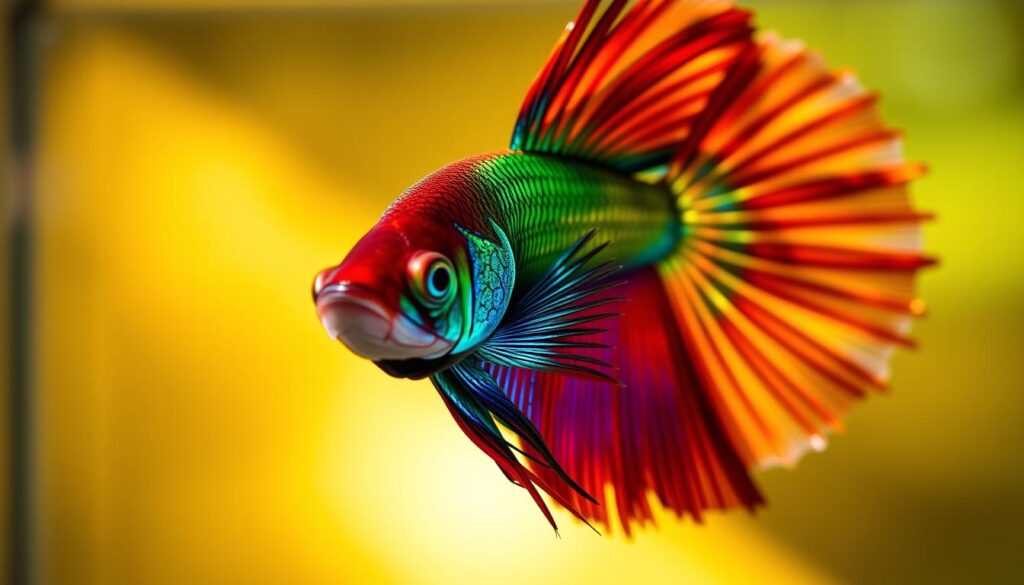
Betta fish also have different tail types and fin shapes. You can find elegant veiltail or dramatic crowntail varieties. Exploring aquarium fish, you’ll see betta fish are truly captivating and stunning.
Some favorite colors of betta fish are:
- Red
- Orange
- Yellow
- Green
- Blue
- Purple
- Black
- White
By mixing these colors, you can create even more unique betta varieties. This makes them a favorite among aquarium lovers.
Read Also Algae in Betta Fish Tanks: How to Keep Your Black White Betta Fish Healthy and Happy
Essential Tank Setup Requirements
Creating a great home for your Elephant Ear Female Betta Fish starts with the tank setup. You’ll need a tank that’s at least 5 gallons big. The water should be between 75 to 82°F (24 to 28°C). This ensures your fish has enough room and the right conditions to thrive.
Keeping your tank clean is key to your fish’s happiness. You’ll need to change the water regularly, clean the tank and its parts, and check the water’s quality. By doing these things, you’ll make a beautiful and healthy space for your female betta fish.
Here are some important things to think about for your betta tank setup:
- Tank size: minimum 5 gallons
- Temperature range: 75 to 82°F (24 to 28°C)
- Water parameters: pH 6.5-7.5, ammonia and nitrite levels at 0 ppm, and nitrate levels under 40 ppm
By following these tips and keeping up with regular maintenance, you can make a happy and healthy home for your Elephant Ear Female Betta Fish.
| Tank Size | Water Change Frequency |
|---|---|
| Small (10 litres) | Weekly, 30-50% water change |
| Medium (20-30 litres) | Every 2 weeks, 10-15% water change |
| Large (50 litres or more) | Monthly, 10% water change |
Creating the Perfect Habitat Environment
For female betta care, a great habitat is key. Elephant Ear Female Bettas need a clean tank with the right lighting, decorations, and filtration. Here are the main things to focus on:
Aquarium fish, like Elephant Ear Bettas, need a balanced home. They like temperatures between 76-82°F (24-28°C) and pH levels of 6.5-7.5. 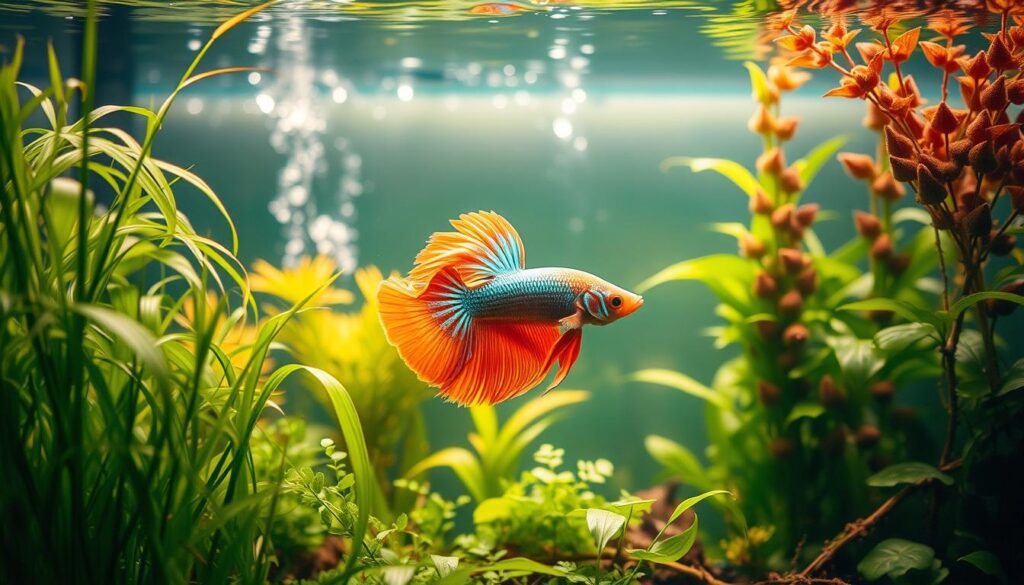
Some unique betta varieties, like the Halfmoon Elephant Ear Betta, have big pectoral fins. They need lots of space and the right tank equipment. Here are some important things to think about:
- Minimum tank size of 5 gallons for a single Betta fish
- Recommended tank sizes for community setups start at 10 gallons
- Proper filtration systems to maintain optimal water quality
By following these tips and thinking about your Elephant Ear Female Betta’s needs, you can make a great home. This will help your aquarium fish stay healthy, happy, and live a long life.
Read Also Blue Halfmoon Betta Fish: The Ultimate Care Guide for This Stunning Beauty.
| Tank Size | Number of Fish | Recommended Equipment |
|---|---|---|
| 5 gallons | 1-2 | Basic filtration system |
| 10 gallons | 2-5 | Advanced filtration system |
Feeding Your Elephant Ear Female Betta Fish
As a responsible aquarist, it’s key to feed your exotic betta fish right. Female betta care means a balanced diet is crucial. Betta fish love meat, so they need a lot of protein. You can give them pellets, flakes, frozen food, and live food.
Feed your Elephant Ear Female Betta Fish twice a day. It’s also good to fast them once a week to help with digestion. Live foods like Daphnia, Brine Shrimp, Bloodworms, and Tubifex Worms are great. They give your betta fish the protein and nutrients they need.
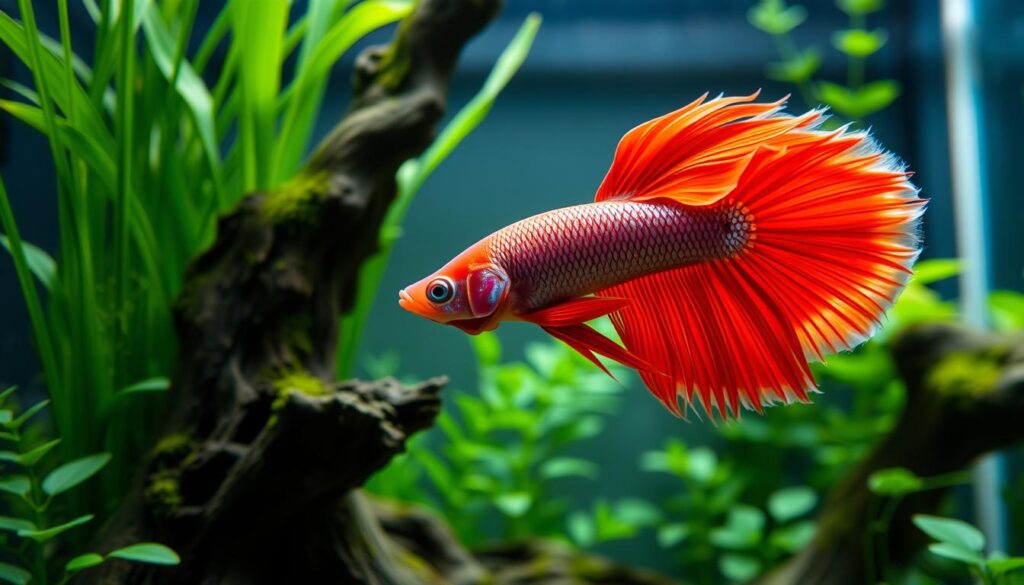
Elephant ear betta fish come in many colors, from blues and reds to greens and purples. In competitions, their pectoral fins must be big and symmetrical. By following these tips and feeding your betta fish right, they’ll be happy and healthy.
Health Monitoring and Disease Prevention
As an owner of an exotic betta fish, it’s key to focus on betta fish care to avoid diseases. Fin rot is a common issue in betta fish, often caused by bad water and high ammonia. Keeping the water clean and checking its quality is vital for female betta care.
To stop fin rot, keep the water quality high. Aim for 0 ppm ammonia and nitrite, and nitrate levels under 40 ppm. A proper filtration system and regular tank cleaning are important. The best water temperature for betta fish is 24-27 degrees Celsius, and the pH should be between 6.5 to 7.5.
Read Also Galaxy Koi Betta Fish: Mesmerizing Aquatic Gems
| Water Parameter | Optimal Level |
|---|---|
| Ammonia | 0 ppm |
| Nitrite | 0 ppm |
| Nitrate | Below 40 ppm |
| pH | 6.5-7.5 |
| Temperature | 24-27 degrees Celsius |
By sticking to these tips and focusing on betta fish care, you can keep your exotic betta fish healthy and happy.
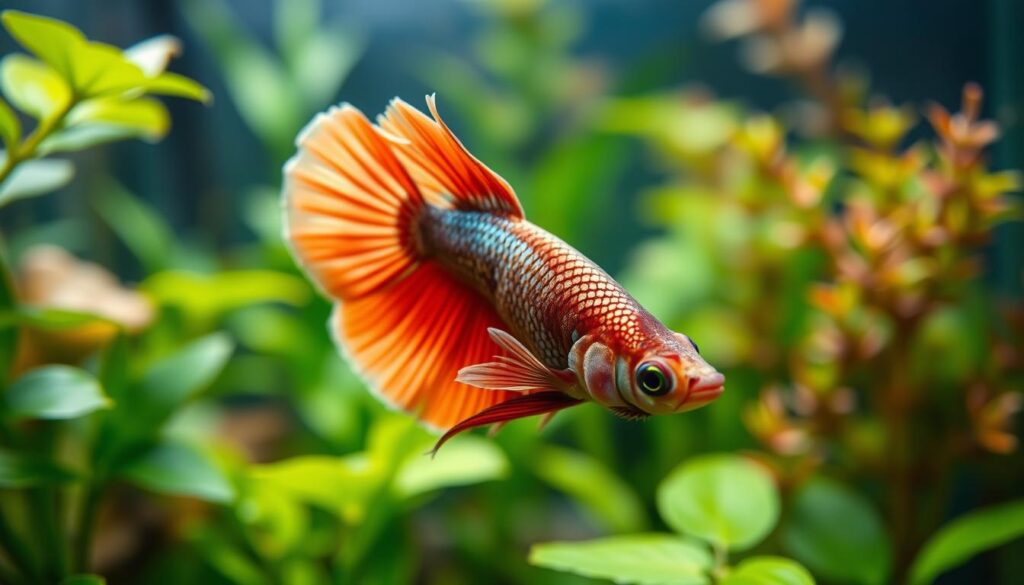
Compatible Tank Mates for Your Female Betta
Choosing the right female betta tank mates is key. Look for peaceful and non-aggressive fish that get along with your Elephant Ear Female Betta. Small fish like harlequin rasboras, neon tetras, and ember tetras are good choices. They do well in schools of 5-10.
Invertebrates like ghost shrimp, corydoras catfish, and mystery snails also make great tank mates.
A well-thought-out betta tank setup is vital for a peaceful home. A 10-gallon tank is the minimum size needed. It should have lots of hiding spots and plants to keep aggression down.
The water should be between 72-81 degrees Fahrenheit and have a pH of 7.0-8.0. This is best for aquarium fish like bettas and their friends.
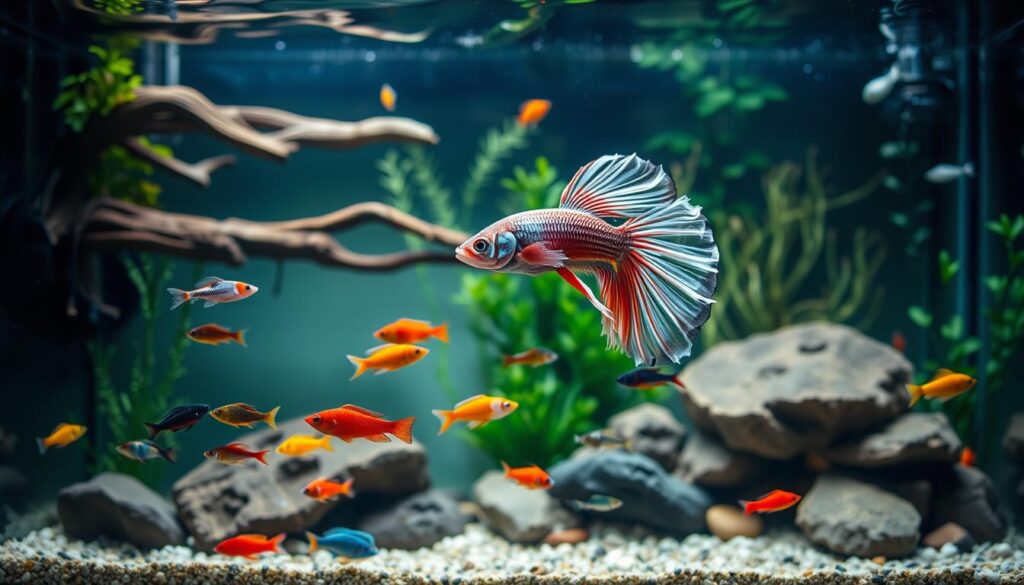
- Introduce tank mates slowly and under close observation
- Choose peaceful and non-aggressive species
- Provide plenty of hiding places and plants
- Maintain optimal water parameters
| Tank Mate | Minimum School Size | Minimum Tank Size |
|---|---|---|
| Harlequin Rasboras | 5-6 | 10 gallons |
| Neon Tetras | 6-10 | 10 gallons |
| Ember Tetras | 4-6 | 10 gallons |
Maintaining Optimal Water Quality
As an aquarium fish owner, I know how vital it is to keep the water quality right for my betta fish. Regular water changes and tests are key for their health. I’ll talk about why these are important and what to test, like pH, ammonia, and nitrite levels.
For betta fish, it’s crucial to change the water often to avoid toxins. I change about 25% of the tank’s water weekly. And I do a full change every two months. This keeps my female betta happy and healthy.
Read Also Do Betta Fish Sleep? The Surprising Truth Every Owner Should Know!
Water Change Schedule
Here’s a water change schedule I stick to:
- Change 25% of the tank’s volume once a week
- Change 100% of the tank’s volume every two months
Testing Parameters
It’s also important to test the water regularly. I check pH, ammonia, and nitrite levels often. Here’s a table with the best water levels for betta fish:
| Parameter | Ideal Range |
|---|---|
| pH | 6.5-8 |
| Ammonia | 0 |
| Nitrite | 0 |
By sticking to this schedule and testing, I make sure my aquarium fish, including my female betta, stay healthy and happy.
Breeding Considerations and Challenges
Breeding exotic betta fish, like the elephant ear variety, comes with its own set of challenges. The trait of having elephant ears is recessive, making it hard to pass on to offspring. To succeed, it’s crucial to pick high-quality parents with clear features and strong genetics.
Some key considerations for breeding elephant ear bettas include:
- Genetic variation: Breeding multiple pairs can increase genetic diversity, but it also increases the risk of undesirable traits.
- Color layers: Understanding the different color layers, such as the blue, black, red, and yellow layers, is crucial for predicting offspring colors.
- Pectoral fin size and condition: In breeding competitions, pectoral fin size and condition are critical judging criteria, with short-tailed dumbo bettas typically having larger, more well-defined fins.
Keeping betta fish healthy is key for successful breeding. This means providing the right environment and diet. A balanced diet with foods like Daphnia and bloodworms is essential. Knowing the specific needs of each betta variety helps breeders succeed.
If you’re interested in breeding exotic betta fish, learning about their needs is crucial. With the right knowledge and care, breeding these unique fish can be a rewarding experience.
| Betta Fish Variety | Pectoral Fin Size | Color Layers |
|---|---|---|
| Elephant Ear | Large, well-defined | Blue, black, red, yellow |
| Short-tailed Dumbo | Large, well-defined | Blue, black, red, yellow |
| Steel Blue | Medium, defined | Blue, black |
Common Behavioral Patterns to Watch For
As a responsible aquarium fish owner, it’s key to know your Elephant Ear Female Betta Fish’s behavior. This helps you give the best care. By spotting signs of health and happiness, you keep your betta fish well-maintained.
A well-kept aquarium is vital for your betta fish. This means regular water changes, a balanced diet, and the right environment. A happy Elephant Ear Female Betta Fish will swim a lot, be curious, and show bright colors. But, stress signs include labored breathing, being very tired, and not wanting to eat.
Signs of Health and Happiness
Here are some signs of a healthy Elephant Ear Female Betta Fish:
- Active swimming and exploring the aquarium
- Bright, vibrant coloration
- Strong appetite and interest in food
Stress Indicators
Stress signs include:
- Labored breathing and rapid gill movement
- Lethargy and lack of interest in surroundings
- Changes in appetite and refusal to eat
By noticing these behaviors, you can make sure your Elephant Ear Female Betta Fish is happy and healthy. This way, you provide the best care for your aquarium fish.
Enrichment and Entertainment Ideas
As an owner of exotic betta fish, I know how key enrichment and entertainment are. Female betta care means making their space engaging and healthy. Here, I’ll share ideas for tank decorations and activities to keep your aquarium fish happy.
For tank decorations, consider these options:
- Adding plants, like Marimo moss balls, for hiding spots and exploration
- Using floating toys, like the Betta Bed Leaf Hammock, for surface resting
- Interactive toys, such as the Zoo Med Floating Betta Exercise Mirror, for exercise and fun
Activity stimulation is vital for your betta’s health. Here are some ideas:
Try different foods, like live Daphnia and Brine Shrimp, to challenge and engage your betta
Create a “playtime” routine with toys or stimuli to boost activity and mental health
By adding these enrichment and entertainment ideas, you’ll make your female betta’s life better. They’ll thrive in a happy, healthy environment.
Troubleshooting Common Issues
As a responsible aquarium fish owner, knowing common issues is key. Problems like fin rot and disease can happen. Regular water changes and checking water quality help prevent these.
Issues like swim bladder disorders, fin rot, and disease can affect your fish. A balanced diet and a clean tank are crucial. Regularly check your fish’s behavior and health to spot problems early.
Here are some tips for troubleshooting common issues:
- Regularly test the water parameters to ensure they are within the suitable range for your female betta fish.
- Provide a balanced and varied diet to keep your fish healthy and thriving.
- Monitor your fish’s behavior and health, and seek advice from a veterinarian if you notice any signs of illness or stress.
By following these tips and staying on top of betta fish maintenance, you can help prevent common issues. A clean and well-maintained aquarium is key for your fish’s health. Remember, a clean tank is essential for your fish’s well-being.
| Common Issue | Cause | Solution |
|---|---|---|
| Fin Rot | Poor water quality | Improve water quality through regular changes and monitoring |
| Disease | Poor water quality, stress | Improve water quality, reduce stress, and provide a balanced diet |
| Swim Bladder Disorder | Genetic predisposition, poor water quality | Improve water quality, provide a balanced diet, and consider veterinary care |
Conclusion: Enjoying Your Aquatic Companion
Reflecting on the world of betta fish, the Elephant Ear Female Betta shines brightly. Their unique looks and colors bring joy to any aquarium fish lover. By following the care tips in this guide, you can create a great home for your Elephant Ear Female Betta.
These fish are perfect for both new and experienced fish keepers. With the right care, they can live for many years. They add beauty and grace to your aquarium. Let the Elephant Ear Female Betta make your aquatic journey special.

